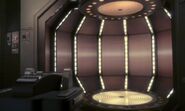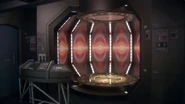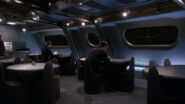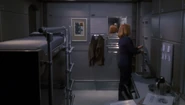Renegade54 (talk | contribs) m (formatting) Tag: sourceedit |
m (lkf ix) Tag: sourceedit |
||
| Line 245: | Line 245: | ||
The scripted description of the bridge was as follows: "''Far more basic than future starships, this command center lacks the 'airport terminal' feel of [[USS Enterprise (NCC-1701-A)|''Enterprise''s A]] through [[USS Enterprise (NCC-1701-E)|E]]. A central captain's chair is surrounded by various stations, the floors and walls are mostly steel, with source light coming from myriad glowing panels. No carpets on the floors, no wood paneling on the walls, high-tech gauges, dials.''" [http://leethomson.myzen.co.uk/Star_Trek/5_Enterprise/Enterprise_1x01_-_Broken_Bow.txt] |
The scripted description of the bridge was as follows: "''Far more basic than future starships, this command center lacks the 'airport terminal' feel of [[USS Enterprise (NCC-1701-A)|''Enterprise''s A]] through [[USS Enterprise (NCC-1701-E)|E]]. A central captain's chair is surrounded by various stations, the floors and walls are mostly steel, with source light coming from myriad glowing panels. No carpets on the floors, no wood paneling on the walls, high-tech gauges, dials.''" [http://leethomson.myzen.co.uk/Star_Trek/5_Enterprise/Enterprise_1x01_-_Broken_Bow.txt] |
||
| − | The interior elements of the NX-class that were sketched in concept artwork by John Eaves included the bridge viewscreen, the helm and the engineering stations on the bridge, the situation room's plotting table, the launch bay, engineering, and sickbay. ({{STC|135}}, pp. 60-62, 64 & 65; |
+ | The interior elements of the NX-class that were sketched in concept artwork by John Eaves included the bridge viewscreen, the helm and the engineering stations on the bridge, the situation room's plotting table, the launch bay, engineering, and sickbay. ({{STC|135}}, pp. 60-62, 64 & 65; {{eavesdropping|2009/06/15/the-navigation-console-of-the-nx-01/}}) In fact, Eaves was instrumental to the design of the bridge consoles. He remarked, "''In the early stages the consoles were being designed in an angled, tubular fashion; these ideas went a ways before the look changed to a more angular look.''" {{Eavesdropping|2009/06/15/the-navigation-console-of-the-nx-01/}} |
Of all the NX-class sets created for the pilot episode {{e|Broken Bow}}, James Mees once characterized the bridge and engineering as "the easiest and hardest, all at the same time" and explained this opinion by commenting of the two selections, "''They're monumental, and although you do have a little bit of room for growth, you pretty much have to get it right.''" The basic design of the bridge was mostly decided upon when Mees joined the project to decorate the sets. "''Herman had already developed the general idea of the bridge, so a lot of it was there and in working order,''" Mees explained. Virtually all the chairs on the bridge were from the aforementioned European showroom, except for the [[command chair]]. After receiving the sketches of the room's work stations from the art department, Mees put together the intricately detailed consoles. ({{STTM|3|3}}, pp. 86 & 85) |
Of all the NX-class sets created for the pilot episode {{e|Broken Bow}}, James Mees once characterized the bridge and engineering as "the easiest and hardest, all at the same time" and explained this opinion by commenting of the two selections, "''They're monumental, and although you do have a little bit of room for growth, you pretty much have to get it right.''" The basic design of the bridge was mostly decided upon when Mees joined the project to decorate the sets. "''Herman had already developed the general idea of the bridge, so a lot of it was there and in working order,''" Mees explained. Virtually all the chairs on the bridge were from the aforementioned European showroom, except for the [[command chair]]. After receiving the sketches of the room's work stations from the art department, Mees put together the intricately detailed consoles. ({{STTM|3|3}}, pp. 86 & 85) |
||
Revision as of 18:13, 6 October 2015
AT: "xx" The NX-class was a type of United Earth starship in Starfleet service during the mid-22nd century. The class is notable for having been the first to be constructed with the warp five engine, allowing Humanity to explore beyond neighboring star systems. The lead ship of the class, Enterprise, was launched in 2151, weeks ahead of schedule, while the second, Columbia, was launched in 2154, after lengthy delays in drydock.
History
United Earth
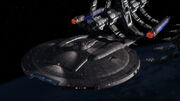
The NX-01 Enterprise departs from spacedock.
The NX-class was conceived of in the early 22nd century as part of the NX Project at the Warp Five Complex: a research and development site on Earth, where Henry Archer, Zefram Cochrane, and Captain W.M. Jefferies, among others, worked on the creation of the warp five engine. (ENT: "Broken Bow", "Home"; Enterprise (NX-01) dedication plaque set artwork)
Starships of the NX-class were far more formidable than the J and Y class freighters that had preceded them. Following the construction of the first starship of the class (the Enterprise NX-01), three more NX-class starships were on the drawing board by August 2151. (ENT: "Broken Bow", "Fortunate Son")
NX-01 Enterprise
Enterprise was launched from the Orbital Drydock Facility on April 12, 2151, under the command of Captain Jonathan Archer. The launch occurred three weeks ahead of schedule because United Earth needed to return the Klingon Klaang to his homeworld. The early launch was strongly protested by the Vulcans, who believed Humanity was not ready to explore space. Ambassador Soval managed to wrangle a concession from Starfleet, forcing the placement of Subcommander T'Pol on Enterprise in exchange for Vulcan star charts. (ENT: "Broken Bow")
The early launch of Enterprise meant that it left spacedock somewhat unprepared: its spatial torpedoes were uncalibrated and its phase cannons weren't even installed. The spatial torpedoes were calibrated in the heat of battle in May of 2151; the ship only survived because of the intervention of the Axanar. (ENT: "Fight or Flight") The phase cannons were not installed until September 2151, while Enterprise battled an unknown enemy. (ENT: "Silent Enemy")
After the Xindi attack on Earth in March of 2153, Enterprise was recalled home. Arriving on April 24th, the ship was refitted and upgraded with new photonic torpedoes, a universal translator update, and a new command center. She was relaunched on a new mission to the Delphic Expanse to search for the Xindi weapon. (ENT: "The Expanse", "The Xindi")
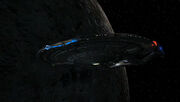
Enterprise in the Delphic Expanse
The search for the Xindi was long and perilous, taking almost a year. In February 2154, Enterprise determined the location of the Xindi weapon and arrived in the Azati Prime system. (ENT: "Stratagem", "Azati Prime") There, the ship suffered severe damage due to multiple attacking Xindi ships. The primary warp coil was destroyed, damage that required drastic actions on the part of Captain Archer to repair. (ENT: "Damage")
Enterprise accomplished its mission to destroy the Xindi weapon and was returned to Earth by a Xindi-Aquatic cruiser following the end of the mission, though it made a slight detour to an alternate timeline's 1944 with the help of Daniels, where the vessel's crew managed to stop Vosk and bring an end to the Temporal Cold War. (ENT: "Zero Hour", "Storm Front", "Storm Front, Part II")
After returning to its own timeline, Enterprise continued to serve the United Earth Starfleet for another seven years. The vessel was decommissioned in 2161. (ENT: "These Are the Voyages...")
NX-02 Columbia
At the time of the Xindi attack on Earth in 2153, the second NX-class starship, Columbia, was still under construction. In November 2154, Columbia was launched under the command of Captain Erika Hernandez. (ENT: "The Expanse", "Affliction")
Compared to the class prototype, Enterprise, Columbia's hull polarization was improved by twelve percent. Furthermore, the ship possessed ventral and dorsal photonic torpedo launchers as well as pulsed phase cannons. Another improvement was that the bridge stations were directly tied into the primary EPS junction. (ENT: "Home")

The NX-02 Columbia in 2154
In November of 2154, Columbia was stuck in drydock with engine trouble, delaying the ship's launch, and rendering it unable to assist Enterprise during a large-scale orchestrated hunt for the Romulan drone-ship. (ENT: "United")
In late 2154, the vessel's engine troubles were fixed upon the transfer of Enterprise engineer Charles Tucker to Columbia, allowing the vessel to be launched in November of that year. (ENT: "Affliction")
Mirror universe
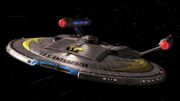
The ISS Enterprise in 2155
In the mirror universe, NX-class battle cruisers were the pride of the Terran Starfleet, with vessels such as the ISS Enterprise and ISS Avenger serving as the flagships of fleets. They were slightly more advanced than the vessels of United Earth, a result of the application of stolen Vulcan technology taken from the T'Plana-Hath in 2063. These vessels primarily used plasma cannons and photonic torpedoes in battle, though they did carry phase cannons as well. (ENT: "In a Mirror, Darkly", "In a Mirror, Darkly, Part II")
Alternate reality
In 2259 of the alternate reality, a miniature of an NX-class starship was displayed in Admiral Alexander Marcus' office on Earth. (Star Trek Into Darkness)
Technical data
Physical arrangement
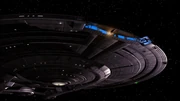
NX-class deflector array
The NX-class consisted of a habitable saucer module that contained seven decks (lettered A through G) and a symmetrical warp field governor located just aft of the saucer section, that regulated the warp field shape that would otherwise break apart at higher warp factors. Two half-decks were inserted between D and E deck, as well as between E and F deck. These contained plasma conduits and access tunnels. Two docking ports were located on either side of the saucer section, accessible on E-deck.
Propulsion systems
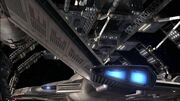
NX-class impulse drive
NX-class ships achieved warp flight through two warp nacelles, which housed multiple pairs of warp coils. Maximum speed was warp 5.2, and the NX-class was the first Earth vessel to achieve warp 5.06. (ENT: "Babel One", "Affliction") Standard cruising speed was warp 4.5. (ENT: "Broken Bow") A retrofitted Enterprise from an alternate timeline was theoretically able to reach warp 6.9 for short intervals. (ENT: "E²") There were two fairing impulse engines, mounted on the aft of the pylons leading to the warp nacelles. The navigational deflector was mounted on the front of the saucer module.
Tactical systems
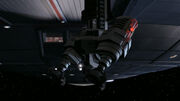
The grapplers
Initially, in 2151, the NX-class starships were designed to carry three phase cannons as the primary weapons of the ship. (ENT: "Silent Enemy") While these were powerful weapons by Human standards at the time, they were still considered to be "low-yield" particle cannons by the Klingons of the era. (ENT: "Judgment") The ship was also fitted with plasma cannons and spatial torpedoes that also turned out to be mostly less than effective in combat. (ENT: "Broken Bow", "Fight or Flight") Later on, the NX-class weapon systems were upgraded to include several more phase cannons. In 2153, photonic torpedoes were installed and improved pulsed phase cannons were developed by 2154. (ENT: "The Expanse", "Home")
The defensive systems of the NX-class were also not as advanced as those of other races at the time. Instead of deflector shields and tractor beams, the NX-class was equipped with polarized hull plating and grapplers.
Shuttlecraft systems
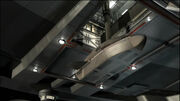
NX-class launch bay
Located mainly on E Deck was the launch bay. The pressurized sector of the bay – limited to E deck – contained the launch bay control room, while the launch bay itself, on F deck, was where the two shuttlepod were docked. A magnetic docking arm extended from the launch bay's ceiling to lower or raise a shuttlepod upon arrival or departure of the craft. (ENT: "Broken Bow", "Fight or Flight")
Interior design
- For deck configuration, see NX class decks.
Command bridge
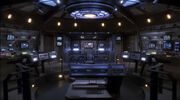
NX-01 command bridge
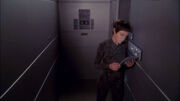
Bridge access corridor
The bridge was the nerve center of every starship. The commanding officer of an NX-class starship sat in the center of the circular-shaped room, surrounded by the duty stations of their science and communications officers to the left, the helmsman in front, and the security chief and chief engineer (or another engineering officer) to the right.
All officers faced the main viewscreen, which was mounted against the forward bulkhead of the bridge. To both sides of the viewscreen was access to a corridor that ran behind the consoles walls to port and starboard. These corridors had access to the ship's lower decks. To the aft of the bridge was the situation room, which served as an informal briefing room to the senior staff. There was also a corridor to port behind a door to the situation room which had access to the ship's lower decks. (ENT: "Broken Bow", "In a Mirror, Darkly")
Upgrades
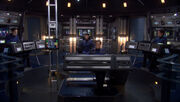
NX-02 command bridge
The bridge of the second NX-class starship launched, Columbia, featured additional columns near the helm and behind the captain's chair. (ENT: "Affliction") These were later added to Enterprise and had been installed by 2161. (ENT: "These Are the Voyages...")
There was also a command center upgrade, a specialized room that was once a storage bay. It was created just before Enterprise went to the Delphic Expanse, for use during the Xindi mission. (ENT: "The Xindi")
Corridors
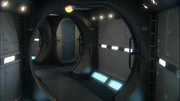
NX-class typical corridor
NX-class corridors were made of a metallic material. They were characterized by circular section separations, for evident mechanical equilibrium reasons. They all had a pair of holders in cases of shaking or turmoil. The circular panels also had a tactical use as defenders could crouch or lean behind them as they fired upon intruders.
Throughout the corridors, communication panels were mounted on the walls. (ENT: "Broken Bow")
Engineering
NX-class engineering room
Located on D Deck was the engine room of the NX-class starship. This class was the first type of Human starship to carry a warp reactor capable of speeds up to warp 5.
After exiting the core, and before being injected into the nacelles, warp plasma was accelerated in the two plasma injectors.
Sickbay
NX-class sickbay
Sickbay was located on deck E of the NX-class. In the center of the room was an operating table, while additional beds were located alongside the walls. The sickbay facility also included a medical laboratory. (ENT: "A Night in Sickbay")
A ladder from the sickbay lead to maintenance shafts. (ENT: "Regeneration")
Armory
NX-class armory, pre-photonic torpedo upgrade
The armory was used to launch spatial or photonic torpedoes and could be used to operate the phase cannons. Although weapons were primarily kept in the armory of the NX-class, the ship possessed a total of fourteen weapons lockers. The armory was originally configured to carry nuclear torpedoes. (ENT: "Acquisition")
Transporter room
In the time of the NX-class, the transporter was usually used for cargo transportation only, although it was capable of transporting people. Most people, however, were uneasy of the device, limiting its use to emergency situations only. (ENT: "Broken Bow")
Mess hall and theater
Located on E Deck was the ship's mess hall, which was used once a week on Thursday as a movie theater. The mess could seat approximately forty people at a time at ten circular metallic tables. Beverages and simple dishes were available from protein resequencers on the walls, while elaborate dishes were prepared in the ship's galley. A small captain's dining room was located near the galley. (ENT: "Vox Sola", "Doctor's Orders", "Singularity", "These Are the Voyages...")
Hydroponics
NX-class starships had a hydroponics facility where fresh fruits and vegetables were grown to supplement the ship's food supply. (ENT: "Breaking the Ice")
Crew quarters
The 87 crew quarters aboard the NX-class starships were located on decks B through E. Very few quarters had a view of space (usually those of the higher-ranked officers).
On D and G decks, there were special quarters for guests visiting an NX-class starship. (ENT: "Cold Front", "Babel One")
Ships commissioned
- Enterprise NX-01
- Columbia NX-02
- NX-03 (planned)
- NX-04 (planned)
Mirror universe
Appendices
Appearances
A list of all appearances of NX-class starships (excluding the regular appearances of Enterprise NX-01):
References
- ENT:
- "Fortunate Son"
- "First Flight"
- "The Expanse"
- "E²"
- "Home"
- "United"
- "The Aenar"
- "Affliction"
- "In a Mirror, Darkly"
- "Demons"
- "Terra Prime"
Background information
Name
The prefix "NX" was formerly used for aircraft registered in the United States as experimental. If the name of this class had followed the protocols of naval tradition, it would have been called "Enterprise-class," as the first ship of a new contract provides the class' name. However, the notion that this class was to be named "NX-class" came from the producers of Star Trek: Enterprise. [1](X) Their reasons for insisting on that designation were unknown to the series' art department. [2](X) Also see Registry.
Model
- See NX class model
Interior
Although the NX-class had to make the impression it was a 22nd-century predecessor to ships of the later centuries portrayed on Star Trek, everything had to be redesigned, including the vessel's interior. For instance, there was no question of simply borrowing a wall from a Star Trek: Voyager set or reusing the consoles with merely a subtle redesign. (Star Trek: The Magazine Volume 2, Issue 7, p. 48)
The cramped living conditions aboard the NX-class were influenced by an experience in which a group of the production staffers personally researched what it was like to spend a day on a nuclear submarine in 2001, about six months before the series started to be broadcast. (Star Trek: Communicator issue 134, pp. 14 & 76) "Rick and Brannon and I did a tour of a nuclear sub that was in a base in San Diego," explained Herman Zimmerman. "That was quite an interesting trip and we learned a lot about what real space you have to work with." (Star Trek: Communicator issue 135, p. 60) Deciding that they didn't want the NX-class interiors to be quite as claustrophobic as those aboard the submarine (out of concerns that such uncomfortably confined areas might be off-putting for the show's weekly audience), the group used conceptual elements from the seafaring craft in their designs for the starship, so that (for instance) the doors aboard the NX-class were made to seem like the heavy-duty hatches of nuclear submarines. (Star Trek: Communicator issue 134, p. 76; Star Trek: Communicator issue 135, p. 60)
Some of the sets and control panels were additionally influenced by NASA designs. (Star Trek: Communicator issue 134, p. 14) In fact, Herman Zimmerman researched, especially for this project, then-current designs that were in development for both NASA and the US military. (Broken Bow, paperback ed., p. 261) Rick Berman explained, "We looked at a lot of film on the various space stations – on Mir and on the [...] International Space Station – and on the interior of the various space shuttles." Berman specified, too, that – as well as wanting the interiors to be "fun" and "cool" with "a sense of excitement" – he and his collaborators tried to "find something in between" the insides of a modern-era spacecraft or submarine and the interiors of the 23rd century. (Star Trek: The Magazine Volume 2, Issue 7, p. 12)
The process of designing the inner environments of the NX-class was a struggle in which Herman Zimmerman played a key role. John Eaves offered, "The internal sets of this ship went through some pretty radical changes as it evolved [....] As much of a fight Doug had with the devilish details of the exterior, my boss had just as many with the interior." [3]
Herman Zimmerman was interested in having the interior sets for the NX-class lightly tinted bronze. "I believe he wanted that for the interiors as well," reckoned Doug Drexler, "although that did not happen." [4](X)
The materials used in the NX-class sets constituted a more hard-edged approach to Starfleet design than what had been established in the franchise, so far. For the shipboard surfaces, the production team, under the direction of Rick Berman and Brannon Braga, used more real metal – including aluminum, steel, copper and brass – than simulated metal. This, thought Herman Zimmerman, made the painted metal surfaces seem "much more believable," as they were often situated directly next to real metal surfaces, convincing a viewer's eye that both types of surface were actually metal. The interiors didn't involve much plastic nor anything, at all, that looked like wood. The producers were also adamant for the sets not to have designer colors and that the flooring would be without carpets. (Star Trek: Communicator issue 135, p. 60)
The production team differentiated the doors aboard the NX-class by having them be non-automatic and entail more security for access. Another method that was used to relate the NX-class' highly utilitarian nature was giving the corridors an extremely basic shape. Much of the lighting for the sets was likewise made more practical; virtually every set was ninety percent lit by the set decorator and Herman Zimmerman, with the latter and his team having selected positions for the spotlights where they could be clearly viewed on-screen. (Star Trek: Communicator issue 135, pp. 60, 65 & 61)
Set decorator James Mees found that his recruitment into the project to decorate the NX-class sets was somewhat complicated. He recalled, "When we started we had virtually no prep time [....] But we had so much stuff to forget about. What we [...] had to do is to take a futuristic attitude but step back in time from the other shows." (Star Trek: The Magazine Volume 3, Issue 3, p. 86)
Much of the furniture in the NX-class interiors was bought from Europe and consisted of items that James Mees thought had been "beautifully designed." Furnishings such as sofas aboard the NX-class were from Italy. Mees noted, "We wanted to be functional, and the Europeans are quite efficient at designing furniture for very small spaces." Moments later, he recalled, "When we started I scouted out everything and showed Herman a whole lot of different pictures. When I knew the direction he wanted to go in I went back to the dealers, and when I knew how much things cost I had him come shopping with me. Then we had a show-and-tell with the producers, with a sample of every single thing; it was like a great big furniture warehouse, with all the stuff that I liked and thought we could use in different places. There was not one single item that Rick Berman and Brannon Braga didn't like, so I was very, very happy!" (Star Trek: The Magazine Volume 3, Issue 3, p. 86)
The NX-class sets were meant to complement the class' exterior. The exact whereabouts of the various shipboard areas, for example, were planned. "It's not so difficult to place the interior sets once you've got the exterior design, but it took us quite a while," stated Herman Zimmerman. (Star Trek: Communicator issue 135, p. 61) However, in their text commentary for "Broken Bow" on the ENT Season 1 DVD, Michael and Denise Okuda unofficially theorized that, based on the fact that the movement of stars viewed from Enterprise's captain's mess changed as the series progressed (seemingly indicating that that room's placement on the ship was altered during the course of the series), the NX-class had movable rooms.
The round windows on the outside of the NX-class saucer section were, upon being designed by Doug Drexler, intended to be portholes. He also hoped the production team would be permitted to include them in a set. Even though this did not happen, Drexler was highly satisfied with the interior sets that were created for the series, describing them as a "spectacular job." [5](X)
Enterprise's scenic art department at first considered whether video playback would be required at all for the displays aboard the NX-class. Scenic Artist James Van Over noted, "We thought they [the producers] might say, 'Well, they didn't use it on [Kirk's] ship, let's just skip it.'" (Star Trek: Communicator issue 144, p. 28)
Selecting the keypads and screens for the NX-class sets proved to be challenging. "We spent quite a lot of time looking at what was available and what we could buy off the shelf, because we can't invent everything [....] We spent a lot of time looking at aircraft control panels, for instance, both ancient and not-so-ancient," recalled Herman Zimmerman, "but those things are really expensive. We would have liked to use aircraft-style LCD screens, for instance, but an LCD screen just turning it from horizontal to vertical would make a big difference, and they use them that way in modern aircraft. But those things cost about $25,000 a piece. And that's in quantity! Mike Okuda did some research and was quoted at $50,000 a piece on some screens that were 9 inches by 12 inches high. They said if we bought more than 10 they could give it to us at $40,000 a piece! [....] We couldn't afford that. We did buy about 80 LCD and plasma screens and none of them cost more than $4,000, much less $40,000." (Star Trek: Communicator issue 135, pp. 61-62)
Ultimately, there was a total of 81 active plasma and LCD screens in the NX-class sets built for the start of the series. Even though the screens were still initially very expensive, their inclusion was planned so that, over the run of the series, a lot less optical burn-ins would be required than had needed to be done for older video screens commonly used in the franchise's past. (Star Trek Monthly issue 84, pp. 28 & 29)
At the start of the series, the graphics on all the plasma screens were designed by Michael and Denise Okuda. (Star Trek Monthly issue 84, p. 28) "Mike Okuda had the idea that the interface would be built out of boxes," said Jim Van Over, "and there would be buttons for the actors to push to give them something to do." (Star Trek: Communicator issue 144, p. 28)
All the standing sets for the NX-class had features which the production crew termed "busy boxes," and which Herman Zimmerman described as "things that can be opened up and worked on [....] Leaving so much more for the actors to do." (Broken Bow, paperback ed., p. 267)
All the standing sets for the NX-class had removable, so-called "wild" walls, to allow for cameras and equipment. (Broken Bow, paperback ed., p. 267) Director James L. Conway was very impressed with the degree of access provided for filming the smaller-than-usual sets (believing that their cramped quality made the areas feel "authentic"). Shortly after completing work on the pilot episode "Broken Bow", Conway attested, "You do have enough room because there's a crane that they use which can poke into the sets, and so in places where you normally couldn't get a Steadicam or a dolly this camera crane can reach out over the consoles and over the floor and move around, so you can actually get fantastic angles." (Star Trek: The Magazine Volume 2, Issue 7, p. 47)
Bridge and other rooms
The NX-class bridge often provided a genesis for the design of the class' other interiors. "Herman Zimmerman would always start with the bridge to set the tone for the overall architecture," remembered John Eaves, "and then branch out carrying the details through the corridors and secondary rooms, based on this master blueprint." [6]
Due to Rick Berman and Brannon Braga liking the bridge of the USS Defiant (NX-74205), the long and narrow shape of the NX-class bridge was influenced by that earlier-created room, as opposed to appearing (in the words of Herman Zimmerman) "elliptical as the Enterprise-D bridge was, or wide as the Voyager bridge was." ("The USS Defiant", DS9 Season 3 DVD special features; Star Trek: Communicator issue 135, p. 62) Other design facets of the NX-class bridge that took their cue from the equivalent area aboard the Defiant-class included the presence of a single helm, instead of two stations for helm and navigation functions, and detailing on the ceiling. Concerning the latter, Herman Zimmerman said, "Much of the treatment of the ceiling has overtones of the Defiant." (Star Trek: Communicator issue 135, p. 62)
Certain parts of the NX-class bridge in common with the TOS Enterprise – for instance, the room's layout featuring a sunken central captain's chair and a scope at the science station – were added at Brannon Braga's request. (Star Trek: Communicator issue 135, p. 19) Another detail of the NX-class bridge that was in homage to that of the traditional Constitution-class was an astrogator at the helm. [7]
Michael Okuda incorporated 1960s-style touch-tone phone buttons on the bridge consoles which seemed as if they might predate the translucent candy-colored buttons installed aboard Kirk's original Enterprise. Many of the other physical controls on the NX-class bridge were fleshed out by Anthony Fredrickson and set designer Wendy Drapanas. (Star Trek: Communicator issue 144, p. 28)
Contrastingly, one aspect of the bridge that intentionally set it apart from the equivalent areas of other ships was its inclusion of the situation room. The bridge was made to encompass this area not only so that the characters would have somewhere to have meetings close to the center of command but also because it facilitated more staging options. (Star Trek: Communicator issue 135, p. 60) Another way in which the bridge was made different, visually, from those of several past classes of ship was by not hiding the monitors under black plexiglas. (Star Trek: Communicator issue 134, p. 14; Star Trek: Communicator issue 135, p. 59) Yet another difference was that the controls were decided, by the producers, to be made essentially more hands-on, with buttons, knobs, gauges, dials, and levers, rather than touch-sensitive panels. (Star Trek: Communicator issue 135, p. 59)
The scripted description of the bridge was as follows: "Far more basic than future starships, this command center lacks the 'airport terminal' feel of Enterprises A through E. A central captain's chair is surrounded by various stations, the floors and walls are mostly steel, with source light coming from myriad glowing panels. No carpets on the floors, no wood paneling on the walls, high-tech gauges, dials." [8]
The interior elements of the NX-class that were sketched in concept artwork by John Eaves included the bridge viewscreen, the helm and the engineering stations on the bridge, the situation room's plotting table, the launch bay, engineering, and sickbay. (Star Trek: Communicator issue 135, pp. 60-62, 64 & 65; [9]) In fact, Eaves was instrumental to the design of the bridge consoles. He remarked, "In the early stages the consoles were being designed in an angled, tubular fashion; these ideas went a ways before the look changed to a more angular look." [10]
Of all the NX-class sets created for the pilot episode "Broken Bow", James Mees once characterized the bridge and engineering as "the easiest and hardest, all at the same time" and explained this opinion by commenting of the two selections, "They're monumental, and although you do have a little bit of room for growth, you pretty much have to get it right." The basic design of the bridge was mostly decided upon when Mees joined the project to decorate the sets. "Herman had already developed the general idea of the bridge, so a lot of it was there and in working order," Mees explained. Virtually all the chairs on the bridge were from the aforementioned European showroom, except for the command chair. After receiving the sketches of the room's work stations from the art department, Mees put together the intricately detailed consoles. (Star Trek: The Magazine Volume 3, Issue 3, pp. 86 & 85)
Many of the NX-class sets were built on Paramount Stages 8 and 9. However, the bridge and armory sets were constructed on Paramount Stage 18. (Star Trek Monthly issue 84, p. 25) The bridge and situation room were the most costly sets of the NX-class interiors to build. (Star Trek Monthly issue 84, p. 29)
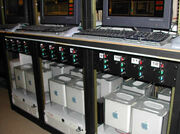
Animated displays managed by Apple G4 Cubes
The NX-class bridge displays were run at a nearby video control room which, like the bridge set, contained many screens, with rack upon rack of monitors that kept quality control over the images on the set, such as previewing displays that were to be switched. Rather than utilizing videotape playback, the displays on the bridge were fed to the set's monitors from Apple G4 Cube computers (of which there were about fifteen to twenty) using CD playback. (Star Trek: Communicator issue 135, p. 62; Star Trek: Communicator issue 144, p. 29) Rick Berman referred to the array of plasma screens on the NX-class bridge as "beautiful." (Star Trek: Communicator issue 134, p. 14)
Aftermath
The NX-class was at first reported to be 190 meters (slightly longer than 600 feet). (Star Trek Monthly issue 84, p. 6; Star Trek: Communicator issue 135, p. 60)
Shortly prior to the launch of the series, Rick Berman cited the standard crew complement of the NX-class as being "around 65 crew members." (Star Trek: Communicator issue 134, p. 76) In Star Trek: Communicator issue 135 (p. 23) and Star Trek Monthly issue 84 (p. 6), the crew complement was said to be 78 and 87 respectively. Star Trek: The Magazine Volume 2, Issue 7 (p. 30) gave a rougher estimate of "between 70 and 80." In unused dialogue from the script for "Fight or Flight", T'Pol refers to the crew of Enterprise as numbering seventy-five. "Strange New World" established the total of eighty-three crew members, a number repeated in later episodes, such as "Silent Enemy", "Oasis", "Singularity", "The Catwalk", "The Expanse", and "These Are the Voyages...".
Rick Berman was ultimately delighted with the look of the NX-class. Not long before the series began airing, he contemplated the design, saying, "We have designed a ship which is very cool while, at the same time, is not as streamlined as the Enterprise has become [....] The whole layout and feel of the ship is different – I don't know if 'retro' is the right word but it certainly is not the ship Captain Kirk was on. However, in every way, it signals and telegraphs what in 90 years will be Kirk's Enterprise [....] [but] the interior design of the ship is, I think, dramatically different than previous Enterprise bridges specifically [....] There is definitely some of that submarine feel to [the NX-class bridge] compared to the bridges of the D or E or Voyager." (Star Trek: Communicator issue 134, pp. 14 & 76)
Jonathan Archer actor Scott Bakula was also pleased with the realistic feel of the NX-class interiors, believing that it helped ground the actors in their work. "I love that it's small," he enthused. "I love that it's based on a submarine [....] I think it has a great feel to it. Sometimes I do feel like I'm in a submarine, banging around. But it feels right." (Star Trek Monthly issue 84, p. 32)
There were several fan complaints that the NX-class looks more advanced than both the original variant of Constitution-class and even the Intrepid-class, due to the creative license the producers originally took with the design of the NX-class, as they preferred not to reduce the appearance of the ship's technology to being limited more than modernity. (Star Trek: Communicator issue 139, p. 51) At the time, Manny Coto was one of the fans who felt the NX-class was too advanced. "I would have preferred that, you know, the Enterprise looked more like a crude battleship," he noted. ("Before Her Time: Decommissioning Enterprise, Part One: New Voices", ENT Season 4 Blu-ray special features)
Doug Drexler ultimately wished that the overall exterior of the NX-class had been brighter than it ultimately was, stating, "The NX appeared dark and dingy on actual show. Against space it was often hard to see. Not to my taste." [11](X)
The tight formation flying performed by the Enterprise and Columbia in "Divergence" had some real world roots as Mike Okuda remembered; "In 'Divergence', we had that really cool action sequence with the Enterprise and the Columbia flying in formation, and an EVA crew transfer between ships at warp. Judith and Garfield Reeves-Stevens, who wrote the episode, said it was inspired by NASA’s contingency plans to rescue astronauts from a damaged space shuttle orbiter." [12](X)

NX-class schematics
A master systems display style cross-section of the NX-class appeared in the Propworx auction catalog. [13]
Several consoles and panels from the NX-class bridge and other sections were sold off on the It's A Wrap! sale and auction on eBay. [14] [15] [16] [17]
Apocrypha
In the video game Star Trek: Elite Force II, a computer on the Enterprise-E had information on the NX project on display.
The Pocket ENT novels Kobayashi Maru and Beneath the Raptor's Wing have depicted the manufacture of four additional NX-class ships, all named for American space shuttles: Challenger (NX-03), Discovery (NX-04), Atlantis (NX-05), and Endeavour (NX-06). Beneath the Raptor's Wing further depicts development of the NX-class being suspended due to Earth's war with the Romulans, owing to the high costs and time involved in building an NX-class ship. Starfleet's shipbuilding efforts were refocused on the older Daedalus-class ships, which were comparatively faster and cheaper to construct.
The Pocket TNG novel Indistinguishable from Magic establishes that production on NX-class ships resumed after the Earth-Romulan War, and that, according to Jean-Luc Picard, the total number of NX-class vessels rose to "fifteen or sixteen" before the class was finally retired. One such vessel, Intrepid (NX-07), featured prominently in the novel.
A subsequent Pocket ENT novel, A Choice of Futures, which depicts the early years of the Federation Starfleet, establishes that the NX-class is redesigned into a new class of starship, the Columbia class, as of 2162. Chief amongst the class' upgrades is the addition of a TOS-style cylindrical secondary hull section, an intentional homage by author Christopher L. Bennett to Doug Drexler's original design and later redesign of the NX-class vessel. Jonathan Archer, by the time of the novel an admiral, named the class after the Columbia, the first NX class ship to be lost in the line of duty (as seen in the Star Trek: Destiny novel trilogy), and decreed that not only would the only NX-class starship to remain in service, Endeavour, be refitted into a Columbia-class ship, but that all future NX-class vessels would be constructed as Columbia-class ships, effectively phasing out the original design. Also instituted is the addition of the "USS" prefix to Starfleet ship names and the replacement of the "NX" registry number prefix with "NCC."
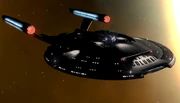
An NX-class ship in Star Trek: Legacy
The PC and Xbox 360 game Star Trek: Legacy depicted further NX-class ships with the Avenger NX-09, a "prime" universe counterpart to the mirror universe ISS Avenger NX-09, and the Currie NX-16.
In the game Star Trek Online, new player captains are able to purchase a replica of the NX-class to fly as their starter ship from the in-game C-Store. The NX-class ship is similar to the Miranda-class starter ship, but is classified as a Light Escort rather than a Light Cruiser, and places an emphasis on tactical systems.
External link
- NX class at Memory Beta, the wiki for licensed Star Trek works

